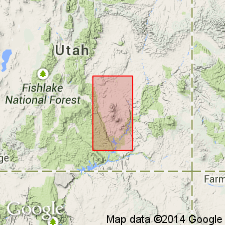
- Usage in publication:
-
- Blue Gate sandstone*
- Modifications:
-
- Original reference
- Dominant lithology:
-
- Sandstone
- AAPG geologic province:
-
- Paradox basin
Summary:
Pg. 4+. Blue Gate sandstone. Heavy-bedded yellow sandstone, 500 feet thick, underlying Masuk shale and overlying Blue Gate shale in Blue Gate Plateau. Present in Henry Mountains region, [Wayne and Garfield Counties], central southern Utah. Age is Late Cretaceous.
[GNC remark (ca. 1938, US geologic names lexicon, USGS Bull. 896, p. 219): Blue Gate sandstone member of Mancos shale. Now treated by USGS as a member of Mancos shale in Henry Mountains region.]
Source: US geologic names lexicon (USGS Bull. 896, p. 219).

- Usage in publication:
-
- Bluegate sandstone
- Modifications:
-
- Not used
- AAPG geologic province:
-
- Paradox basin
Summary:
Pg. 84. Emery sandstone member of Mancos shale extended into Henry Mountains; replaces Bluegate sandstone [Blue Gate sandstone] as used by Gilbert (1877).
Source: US geologic names lexicon (USGS Bull. 1200, p. 395).
For more information, please contact Nancy Stamm, Geologic Names Committee Secretary.
Asterisk (*) indicates published by U.S. Geological Survey authors.
"No current usage" (†) implies that a name has been abandoned or has fallen into disuse. Former usage and, if known, replacement name given in parentheses ( ).
Slash (/) indicates name conflicts with nomenclatural guidelines (CSN, 1933; ACSN, 1961, 1970; NACSN, 1983, 2005, 2021). May be explained within brackets ([ ]).

